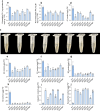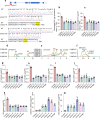Polymerization of proanthocyanidins under the catalysis of miR397a-regulated laccases in Salvia miltiorrhiza and Populus trichocarpa
- PMID: 39929881
- PMCID: PMC11811200
- DOI: 10.1038/s41467-025-56864-0
Polymerization of proanthocyanidins under the catalysis of miR397a-regulated laccases in Salvia miltiorrhiza and Populus trichocarpa
Abstract
Proanthocyanidins (PAs) play significant roles in plants and are bioactive compounds with health benefits. The polymerization mechanism has been debated for decades. Here we show that laccases (LACs) are involved in PA polymerization and miR397a is a negative regulator of PA biosynthesis in Salvia miltiorrhiza and Populus trichocarpa. Elevation of miR397a level causes significant downregulation of LACs, severe reduction of polymerized PAs, and significant increase of flavan-3-ol monomers in transgenic S. miltiorrhiza and P. trichocarpa plants. Enzyme activity analysis shows that miR397a-regulated SmLAC1 catalyzes the polymerization of flavan-3-ols and the conversion of B-type PAs to A-type. Both catechin and epicatechin can serve as the starter unit and the extension unit during PA polymerization. Overexpression of SmLAC1 results in significant increase of PA accumulation, accompanied by the decrease of catechin and epicatechin contents. Consistently, CRISPR/Cas9-mediated SmLAC1 knockout shows the opposite results. Based on these results, a scheme for LAC-catalyzed PA polymerization is proposed. The work provides insights into PA polymerization mechanism.
© 2025. The Author(s).
Conflict of interest statement
Competing interests: The authors declare no competing interests.
Figures










References
-
- Constabel, C. P. Molecular controls of proanthocyanidin synthesis and structure: prospects for genetic engineering in crop plants. J. Agric. Food Chem.66, 9882–9888 (2018). - PubMed
-
- Jun, J. H., Xiao, X., Rao, X. & Dixon, R. A. Proanthocyanidin subunit composition determined by functionally diverged dioxygenases. Nat. Plants.4, 1034–1043 (2018). - PubMed
-
- Joanisse, G. D., Bradley, R. L., Preston, C. M. & Bending, G. D. Sequestration of soil nitrogen as tannin-protein complexes may improve the competitive ability of sheep laurel (Kalmia angustifolia) relative to black spruce (Picea mariana). N. Phytol.181, 187–198 (2009). - PubMed
-
- Deng, Y. & Lu, S. Biosynthesis and regulation of phenylpropanoids in plants. Crit. Rev. Plant. Sci.36, 257–290 (2017).
MeSH terms
Substances
LinkOut - more resources
Full Text Sources
Miscellaneous

